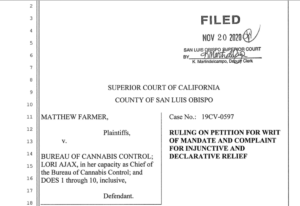Insider reported last week on a court ruling that billboards advertising marijuana will no longer be allowed along California highways. To get a better sense of what comes next, we asked Richard Hamlin of Hamlin Cody, a California based law firm, to provide his perspective.

Background: When California legalized marijuana it established an agency to regulate the industry, the Bureau of Cannabis Control. The Bureau issued a regulation prohibiting marijuana advertising within fifteen miles of the California border on an Interstate Highway or on a State Highway that crosses the state’s border.
San Luis Obispo is in the hills close to the Pacific Ocean, about half-way between San Francisco and Los Angeles. It’s close to an agricultural area and boasts a local California State College. U.S. 101 runs through it.
Matthew Farmer is a general contractor who lives in San Luis Obispo and owns property there. He sued the Bureau, asking the court to invalidate the Bureau’s regulation. He argued that the regulation allowed marijuana advertising if it was at least fifteen miles from the state’s border. He argued that the law legalizing marijuana prohibited all advertising on Interstate Highways and on State Highways that cross the state’s border.
The Decision – Preliminaries: Over two-thirds of the decision discusses issues that only an attorney can love – “ripeness” and “standing.” A case is “ripe” for decision when there as an actual dispute between two parties. “Standing” means that only a person affected by a particular event or regulation can file suit. The judge who heard the case found the issue to be ripe for decision, and that Mr. Farmer had standing to bring the claim.
 The Decision – Substance: Part of the law legalizing marijuana in California prohibits advertising “located on an Interstate Highway or on a State Highway which crosses the California border.” Nothing in the statute limits the ban to the fifteen miles closest to the state’s borders.
The Decision – Substance: Part of the law legalizing marijuana in California prohibits advertising “located on an Interstate Highway or on a State Highway which crosses the California border.” Nothing in the statute limits the ban to the fifteen miles closest to the state’s borders.
The Bureau argued that it was “interpreting” the statute. Mr. Farmer argued that the Bureau was violating the statute. The judge agreed with Mr. Farmer. She ordered Plaintiff to provide an order for her signature. She said she would award attorney fees to Mr. Farmer.
The Decision – Status: The judge’s Ruling is not final. That will not happen until she signs an order (judgment) and the clerk records the judgment. She can reconsider her order or change her mind but that is very unlikely. I have seen judges do that only twice. Once the clerk enters the judgment, the Bureau will have sixty days in which to appeal. We don’t know the Bureau’s intentions.
[wpforms id=”9787″]
Paid Advertisement

















